There is an upside to a recession, I thought to myself. My head down, arms paddling too hard against wind and waves to worry about getting tired. The kayak slid through the waves; its flexible frame snaking up and down, throwing spray in the air with each rise and fall.
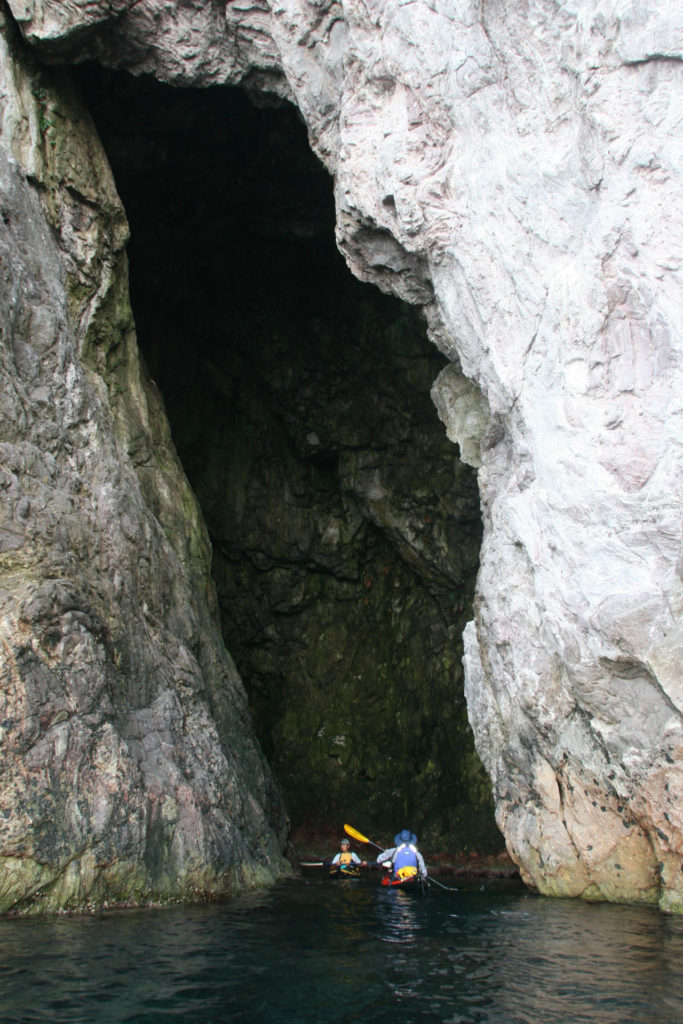
If work hadn’t gone south, I would not have had a whole, uninterrupted week to paddle around Sado. Ogi Port, our starting point and our final destination, was quickly approaching. I grinned and felt proud of what we had done. I realized then I had hardly turned on my phone for a week; an accomplishment in itself.
Leading our group was my neighbor and fellow mountain guide Toyokazu Nakano, who always has time for an adventure. Tomokazu Watanabe is a civil servant in Niigata City, which apparently means taking time off isn’t too difficult, while Jun Tanaka, a schoolteacher in Kobe, was still on summer break. I, the happily underemployed, rounded out the group.
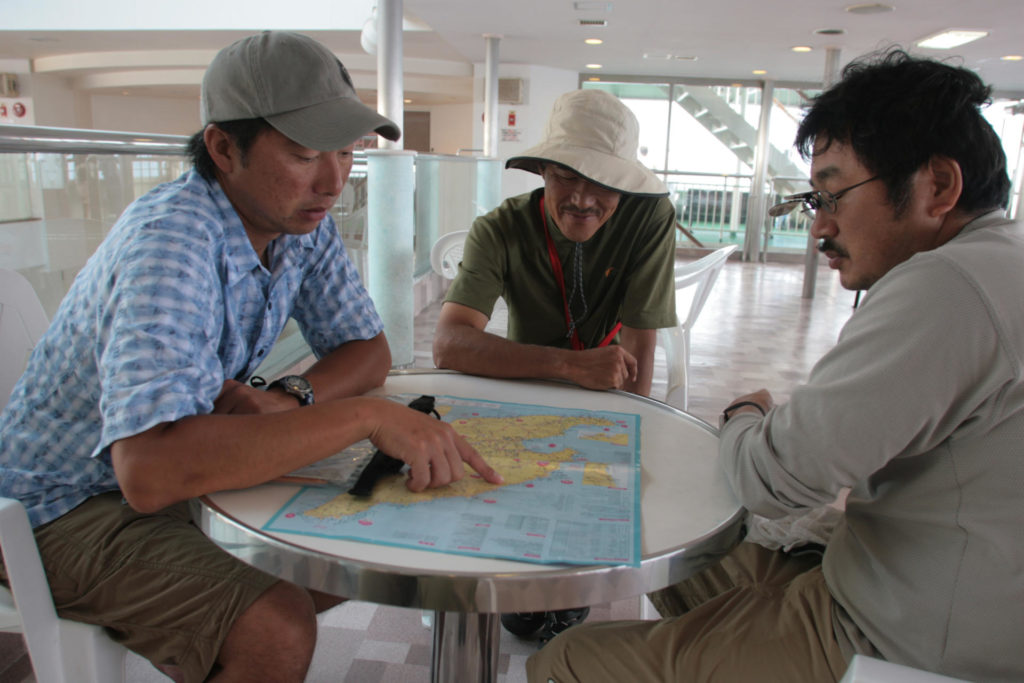
Day 1
The trip began with a two-and-a-half hour ferry trip from Niigata’s Naoetsu Port to Sado Island. It was not a first trip for anyone except Tanaka. Yet none of us had kayaked all the way around Japan’s sixth-largest island. We were using folding kayaks, an ideal way of getting around since you can always bail on a trip, pack the boat in a backpack, and bus your way back to civilization if need be. When the ferry landed, our immediate task was to build and pack the boats at a nearby boat slip under the watchful eyes of the local women paddling taraibune, the traditional half-barrel boats tourists come to see in Ogi.
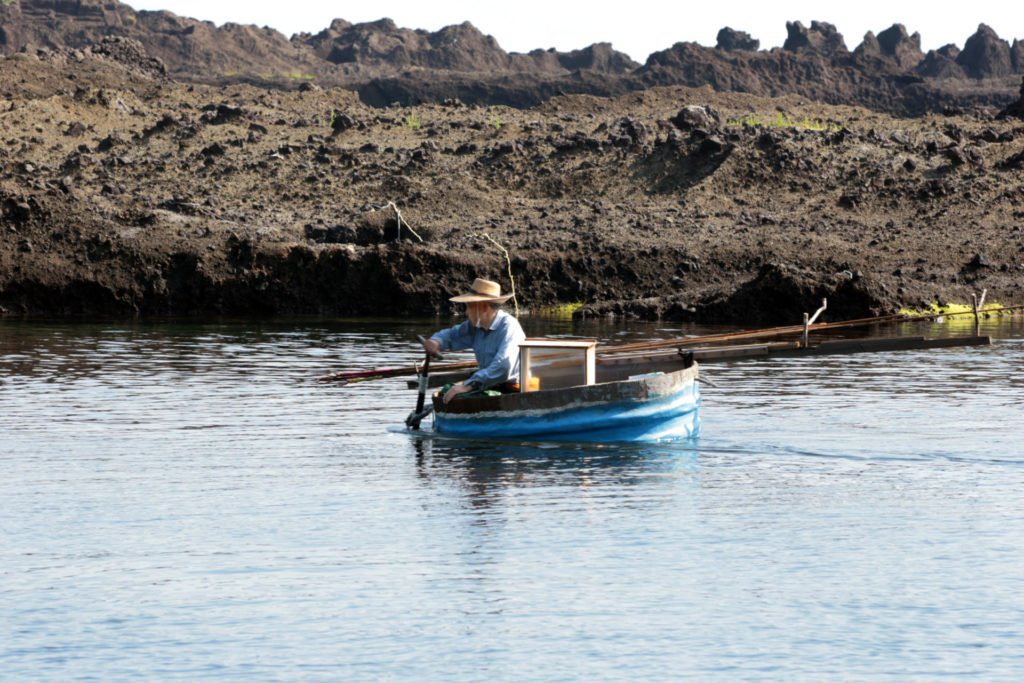
I wondered how they could spend all day in the tubs, dressed in short kimono, aprons, headscarves, gauntlets and the folded, face-obscuring straw hats that are a symbol of the island. They looked cool and calm, gracefully performing a difficult-looking figure-eight sculling stroke to propel the boats around the harbor.
We were now all drenched in sweat, straining over aluminum frames and Hyperlon hulls, cramming dry bags into every corner of the boats. We had arrived on the first day of Earth Celebration, the annual music festival hosted by Kodo, the acclaimed taiko group, whose village is near Ogi. We enjoyed a good curry lunch and cold drinks in the flea market before we took off. The rhythm of drums would follow us for the next two days around the southern tip of the island.
The first day would be a short one, traveling along the coast for less than five kilometers. In that short distance, we gained a sense of the beauty of the island’s coast, with countless rocky inlets, tiny islets and our first sea cave. There would be many more.
Entering a rocky bay near the town of Shukunegi, we were startled to see another taraibune coming ashore, piloted not by a local woman, but an elderly angler, festooned with bamboo poles tipped with metal hooks. In this area, we found, the boats are still used pursuing awabi (abalone) and sazai (turbo shells).
“I’m going fishing,” Watanabe announced, starting a trend that would continue for the rest of the week. Nakano decided to snorkel for some shellfish and Tanaka got out a book, while I made a half-hearted attempt to catch some mackerel. The result of our effort was two mackerel, a couple awabi and a thirst, so we wandered into Shukunegi to hunt down some cold beer, another trend, especially paddling in hot weather with strong tailwinds during the first half of the journey. I kicked myself for not bringing my camera, though, for Shukunegi turned out to be full of interesting old buildings, an ancient well and narrow walkways between houses.
We asked a fisherman to point us toward the liquor store which turned out to be a private home (without signs). No village on Sado, we found, is too small to have a beer dispensary.
First camping dinners are never smooth. What to cook? What to share? What to eat? As darkness set in, so did the arrival of a wave of large, mottled pill bugs. We watched them swarm around a dropped fish head, cleaning it to bone in no time, until Nakano called out. “Itai! They’re biting!” So we retreated to the tents, spending an itchy night listening to them crawling over the fabric.
Day 2
Morning arrived without a bug in sight, although everything left outside—cutting boards, shells and fish skeletons—was absolutely clean. The daily routine of striking camp, loading the boats, reviewing maps and heading out for an adventurous day had begun—and I loved it.
Rounding the southern tip of Sado, we saw several more older men in taraibune, peering down through a glass-bottomed box, snagging shellfish. “Ohayo!” the puckish Watanabe would call out, inevitably startling the fishermen with a waterborne morning aisatsu.
The rock formations in this area are positively lunar, a reminder of the huge winter storms that crash in from Siberia. The result is great sea kayaking, with vast stretches of rock gardens, channels and arches to wander through.
The only downside was we all holed our boats; at one point, Watanabe didn’t know he had a gash across the hull, until he started complaining that his boat was slowing down. “You’re halfway down in the water!” Nakano shouted, hustling him off to the shore for a draining and a patch.
Sado has an unusual shape, like two separate islands lying diagonally to each other with a low-lying area filling in the space between. Our second day meant a five-kilometer-plus crossing of Mano Bay. Not a huge distance, but I learned something while barely seeing the distant coast in the haze during the crossing.
First, it feels as if motion stops as you paddle and paddle while nothing seems to change; second, Japanese kayak guides are heartless automatons who never need water. Not true, of course, but Nakano kept powering on without a break, while I kept gulping down water. I’d get my revenge in the headwinds, though.
Well-worn after the passage, we camped on the concrete steps of an unused, partly overgrown park—until the last night, we never had anyone pass close to our camping spots. No nosy cops, no field-tending farmers, no firework-waving juveniles.
Instead, we quietly watched fishing boats sputter into the port of Sawada. Tanaka and I toasted the night with a cold beer, Watanabe pulled out some imo shochu, and then we retired to a pill bug-free sleep.
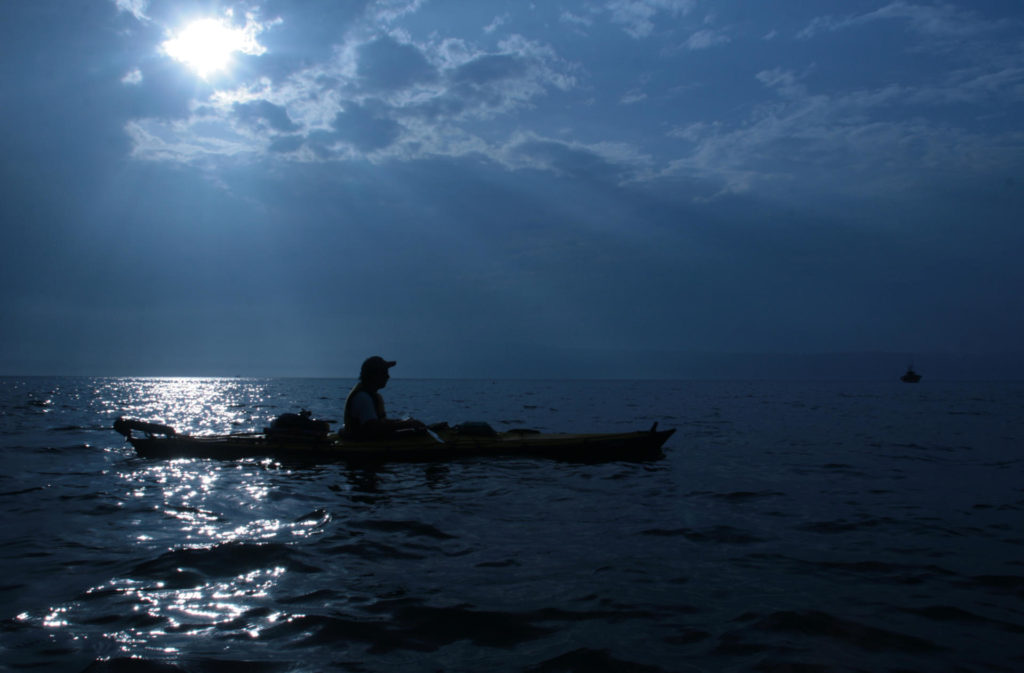
Day 3
I woke up excited, because today we would pass through Aikawa, home to Sado’s famous gold mine, and Senkaku Wan, a rocky bay and popular tourist attraction. A British friend and veteran sea kayaker had been so violently rocked here by “clapotis”—the confused standing waves that bounce off cliffs and cement walls—he was forced to swim his boat to shore.
Luckily for us, the gentle southerly tailwinds held on, so it was a safe, if sweaty, journey into the wonderfully colored rock formations. The only danger came from the faster of two tourist boats rocketing through the narrow channel a little too quietly.
We also passed the ruins of guardhouses and piers that oversaw the delivery of gold-rich ore to ships offshore, a reminder that the gold mine, once the richest in Asia, was still producing until 1989.
We made a supermarket run in Aikawa just before entering Senkaku, so we were set for the evening. We camped on a sandy horseshoe beach and enjoyed a quick snorkel (and a failed attempt at hauling out an octopus spotted under some rocks). Looking at my oversized tent and all the gear we were carrying was a reminder of one of the joys of sea kayak camping, which means not having to carry everything on your back or bicycle. You simply aren’t aware of the sizeable load stashed in your boat.
Day 4 A long day, as we intended to round the northern tip of the island and move from the Soto-kaifu, the outer sea, to the Uchi-kaifu, the inner on the Honshu side. Things looked a little stormy after a crossing; suddenly a fisherman with a snappy straw hat zoomed by, hollering, “The wind’s coming!”
All the other boats in the area, little more than rowboats with small outboards, suddenly came racing in. We paddled like mad for the breakwater of an unnamed port near the tiny town of Ishina, just before a solid wall of wind arrived with a blast of sea spray.
After thanking the fisherman and waiting for the wind to subside, we headed off again, breaking for lunch near an unnamed waterfall on a beautiful rock beach covered in plastic junk bearing Russian and Korean markings. Nakano found some rolled-up pieces of birch bark. “They’re fishing floats, I read about these,” he said, “probably from Russia or North Korea.”
Heading north, we soon came to Onogame, the turtle-shaped rock formation on the northern tip of Sado. The cliffs are especially high and spectacular here; a hayabusa (peregrine falcon) streaked though the peaks as we passed through. Ahead was the one portage of the trip: a three-meter drag across a spit of sand leading to Futatsugame, the second turtle rock.
Day 5

A day spent fighting rain and wind. After a rustic camp in the woods, just south of the tip of the island, we only made it as far as Washizaki before headwinds and pelting rain convinced us to head in for an early lunch and a little fishing.
We were shocked when we spotted the breakwater; waves from the Soto-kaifu the previous winter had knocked part of the huge concrete structure into the ocean; another section looked as if it had been bombed. As windy as it was, it was hard to imagine wind and waves that could twist and shatter huge concrete walls.
The wind let up right after lunchtime, so it was back to the boats, but then it picked up again. We found ourselves with solid rock walls on our right, no place big enough to camp and no way up to the road high above. Suddenly, at a place marked Benten Iwa on the map (one of many “Benten Iwas” and “Benten-zakis”), a steep set of stairs and a building appeared.
Watanabe was fading fast; Tanaka was white-knuckling his paddle as he fought the relentless wind—it was time to escape. Happily dragging the boats to the beach covered in large, well-rounded rocks, we climbed the concrete steps to find a tiny restaurant full of divers filling out their dive cards.
“You the guys in the boats?” an older, gold-toothed woman in an apron asked. “Taihen deshoo, kono kaze!”
Benten Shokudo, marked with a hand-lettered Formica sign, was an oasis. What started with an inquiry for food became a delightful overnight stay. The owner quickly warmed up to us and, adding side dishes to our original order, said, “You should stay up here tonight. There are snakes down on the beach.”
The thought of carrying our gear up all those stairs worried us more than the snakes, so we politely declined, but not before a dinner party under Benten’s tarp-covered outdoor dining area.
Day 6
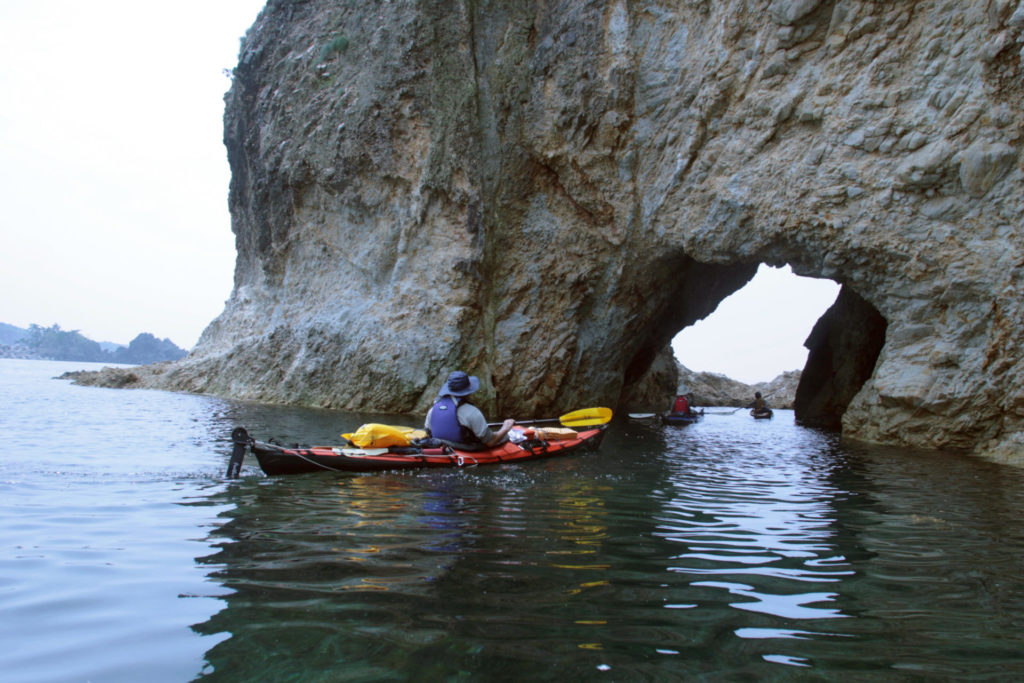
With considerable kilometers still ahead, time was beginning to be an issue. To finish within the week, we still had to cross Ryotsu Wan, a bigger bay than Mano, made even more interesting by the regular arrival of ferries and jetfoils from Niigata City.
After a warm farewell to our Benten Shokudo hosts, we headed out in moderate winds to see just how far we could get. Watanabe kept falling behind, and it became clear, as the winds got stronger, his resolve weakened. We pulled in for a break at a bus stop in a town called Tamasaki, the point from which we would start heading across the bay to a place called Ryotsu-Ogawa. Suddenly, though, we were three.
“I’m going to Ryotsu,” Watanabe announced. It made sense, in a way; he was going back to Niigata City, and nearby Ryotsu was the closest port. It still came as a shock that our lead fisherman was gone and there would be no more imo shochu. Nakano had a ferry schedule, and we had to get going. We watched the path of the boats as we began the long crossing, timing it so we would be in the channel when nothing was scheduled to come through.
Things looked good right up to the far side of the bay, when suddenly the boxy shape of a jetfoil came around Himezaki Point. He wasn’t on the schedule, but he was heading right toward us at high speed. Luckily, he turned toward the port just before we started waving paddles in the air.
The crossing finished, we took a break in the surprisingly historical and artistic little town of Ryotsu-Ogawa, It was a solid paddle the rest of the day down a coastline of hills and trees sparsely sprinkled with tiny towns. In all, we paddled 46 kilometers that day to Matsugasaki, another town with a lot of history and a grass-covered campground under a lighthouse. We cooked dinner in the dark and prepared breakfast, since we had to be up at 4 a.m. to have any chance of catching the mid-day ferry back home.
Day 7
A sleepy breakfast, a quick pack, and we were ready to go. My companions, however, seemed uncertain about getting in the boat. “Ikoo yo!” I urged—I used to love nighttime canoeing back home in Minnesota—but I soon found Nakano, a kayak-marathon-winning paddler, wasn’t comfortable launching in the dark.
The clock finally won out, though, and we were soon paddling silently across a glassy sea toward the lights of the next point down the coast, or so we thought. As dawn slowly arrived, we realized the lights were actually on anchored boats. As the day grew, so did the wind; this time with increasing waves. The wind had not behaved as predicted and, on our final day, it was going to challenge us all the way to our destination.
Coming around the last point, the southwest wind was in our faces, with waves growing. The walls to our right had become sharp cliffs, and we found ourselves in standing waves close to the shore. Suddenly, a white smokestack came into view and Ogi—a little more work, and we were home.
About an hour later, we were back among the taraibune, breaking down boats and racing to get to the ferry. We had no time to spare, but spirits were high as we basked in a sense of accomplishment.
We had spent a glorious week experiencing the natural beauty and history on this island from a perspective that can’t be matched from land. Perhaps there is a sense of irony that Sado, once a prison, a place of exile, for us felt so liberating.




